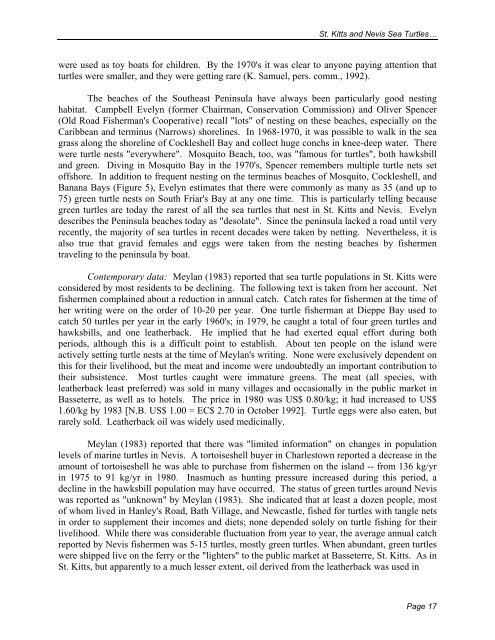Sea Turtle Recovery Action Plan for St. Kitts and Nevis - WIDECAST
Sea Turtle Recovery Action Plan for St. Kitts and Nevis - WIDECAST
Sea Turtle Recovery Action Plan for St. Kitts and Nevis - WIDECAST
Create successful ePaper yourself
Turn your PDF publications into a flip-book with our unique Google optimized e-Paper software.
<strong>St</strong>. <strong>Kitts</strong> <strong>and</strong> <strong>Nevis</strong> <strong>Sea</strong> <strong>Turtle</strong>s…<br />
were used as toy boats <strong>for</strong> children. By the 1970's it was clear to anyone paying attention that<br />
turtles were smaller, <strong>and</strong> they were getting rare (K. Samuel, pers. comm., 1992).<br />
The beaches of the Southeast Peninsula have always been particularly good nesting<br />
habitat. Campbell Evelyn (<strong>for</strong>mer Chairman, Conservation Commission) <strong>and</strong> Oliver Spencer<br />
(Old Road Fisherman's Cooperative) recall "lots" of nesting on these beaches, especially on the<br />
Caribbean <strong>and</strong> terminus (Narrows) shorelines. In 1968-1970, it was possible to walk in the sea<br />
grass along the shoreline of Cockleshell Bay <strong>and</strong> collect huge conchs in knee-deep water. There<br />
were turtle nests "everywhere". Mosquito Beach, too, was "famous <strong>for</strong> turtles", both hawksbill<br />
<strong>and</strong> green. Diving in Mosquito Bay in the 1970's, Spencer remembers multiple turtle nets set<br />
offshore. In addition to frequent nesting on the terminus beaches of Mosquito, Cockleshell, <strong>and</strong><br />
Banana Bays (Figure 5), Evelyn estimates that there were commonly as many as 35 (<strong>and</strong> up to<br />
75) green turtle nests on South Friar's Bay at any one time. This is particularly telling because<br />
green turtles are today the rarest of all the sea turtles that nest in <strong>St</strong>. <strong>Kitts</strong> <strong>and</strong> <strong>Nevis</strong>. Evelyn<br />
describes the Peninsula beaches today as "desolate". Since the peninsula lacked a road until very<br />
recently, the majority of sea turtles in recent decades were taken by netting. Nevertheless, it is<br />
also true that gravid females <strong>and</strong> eggs were taken from the nesting beaches by fishermen<br />
traveling to the peninsula by boat.<br />
Contemporary data: Meylan (1983) reported that sea turtle populations in <strong>St</strong>. <strong>Kitts</strong> were<br />
considered by most residents to be declining. The following text is taken from her account. Net<br />
fishermen complained about a reduction in annual catch. Catch rates <strong>for</strong> fishermen at the time of<br />
her writing were on the order of 10-20 per year. One turtle fisherman at Dieppe Bay used to<br />
catch 50 turtles per year in the early 1960's; in 1979, he caught a total of four green turtles <strong>and</strong><br />
hawksbills, <strong>and</strong> one leatherback. He implied that he had exerted equal ef<strong>for</strong>t during both<br />
periods, although this is a difficult point to establish. About ten people on the isl<strong>and</strong> were<br />
actively setting turtle nests at the time of Meylan's writing. None were exclusively dependent on<br />
this <strong>for</strong> their livelihood, but the meat <strong>and</strong> income were undoubtedly an important contribution to<br />
their subsistence. Most turtles caught were immature greens. The meat (all species, with<br />
leatherback least preferred) was sold in many villages <strong>and</strong> occasionally in the public market in<br />
Basseterre, as well as to hotels. The price in 1980 was US$ 0.80/kg; it had increased to US$<br />
1.60/kg by 1983 [N.B. US$ 1.00 = EC$ 2.70 in October 1992]. <strong>Turtle</strong> eggs were also eaten, but<br />
rarely sold. Leatherback oil was widely used medicinally.<br />
Meylan (1983) reported that there was "limited in<strong>for</strong>mation" on changes in population<br />
levels of marine turtles in <strong>Nevis</strong>. A tortoiseshell buyer in Charlestown reported a decrease in the<br />
amount of tortoiseshell he was able to purchase from fishermen on the isl<strong>and</strong> -- from 136 kg/yr<br />
in 1975 to 91 kg/yr in 1980. Inasmuch as hunting pressure increased during this period, a<br />
decline in the hawksbill population may have occurred. The status of green turtles around <strong>Nevis</strong><br />
was reported as "unknown" by Meylan (1983). She indicated that at least a dozen people, most<br />
of whom lived in Hanley's Road, Bath Village, <strong>and</strong> Newcastle, fished <strong>for</strong> turtles with tangle nets<br />
in order to supplement their incomes <strong>and</strong> diets; none depended solely on turtle fishing <strong>for</strong> their<br />
livelihood. While there was considerable fluctuation from year to year, the average annual catch<br />
reported by <strong>Nevis</strong> fishermen was 5-15 turtles, mostly green turtles. When abundant, green turtles<br />
were shipped live on the ferry or the "lighters" to the public market at Basseterre, <strong>St</strong>. <strong>Kitts</strong>. As in<br />
<strong>St</strong>. <strong>Kitts</strong>, but apparently to a much lesser extent, oil derived from the leatherback was used in<br />
Page 17
















